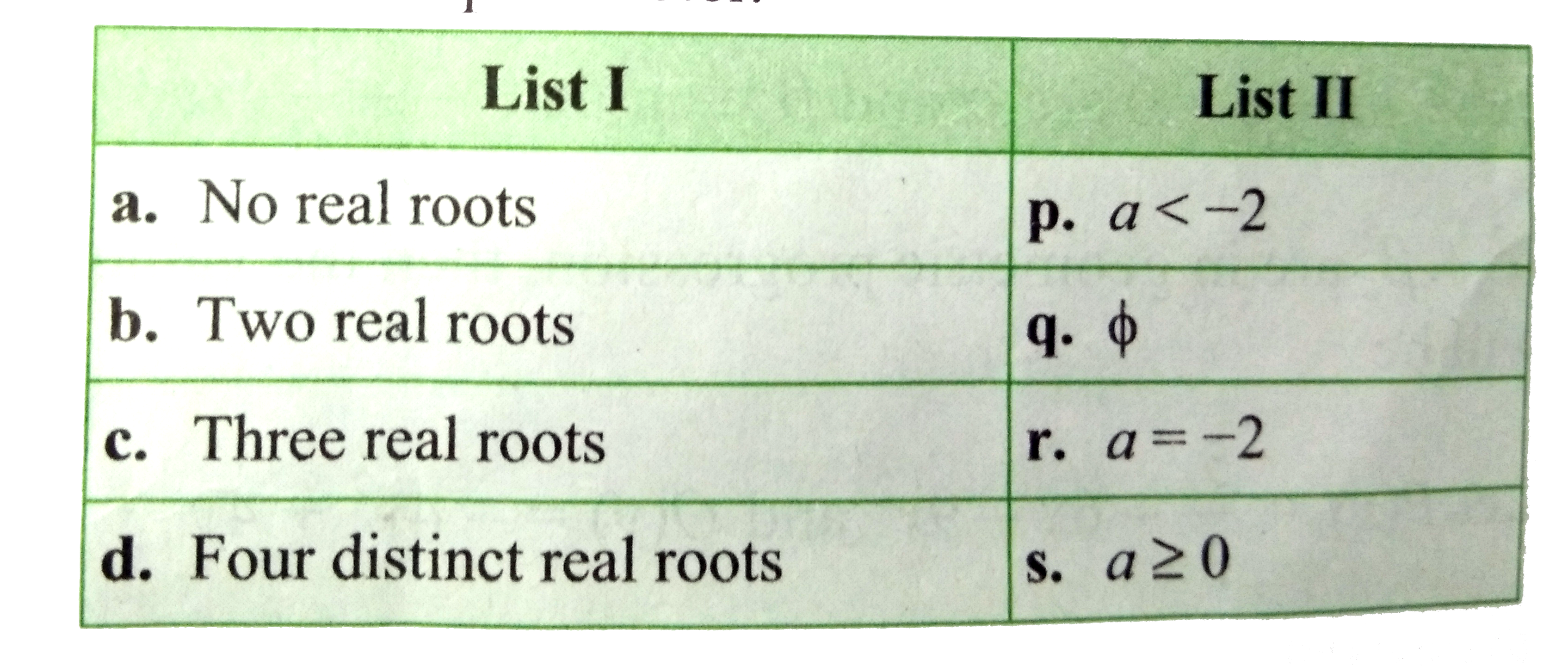the roots of the equation (a+√b)x2−15+(a−√b)x2−15=2a where a2−b=1 areSolution in Bengali
±4
±3
±√14
±√5
The correct Answer is:1,3
We have (a+√b)x2−15+1(a+√b)x2−15=2a
y2−2ay+1=0, where y=(a+√b)x2−15
∴y=a±√a2−1=a±√b=(a+√b)x2−15
So, x2−15=±1
∴x=±4,√14 .
Topper's Solved these Questions
- BOOK - CENGAGE PUBLICATIONCHAPTER - THEORY OF EQUATIONSEXERCISE - Linked Comprechension Type37videos
THEORY OF EQUATIONS
- BOOK - CENGAGE PUBLICATIONCHAPTER - THEORY OF EQUATIONSEXERCISE - MATRIX MATCH TYPE6videos
THEORY OF EQUATIONS
- BOOK - CENGAGE PUBLICATIONCHAPTER - THEORY OF EQUATIONSEXERCISE - Single Correct Answer Type : Exercise89videos
THEORY OF EQUATIONS
- BOOK - CENGAGE PUBLICATIONCHAPTER - STRAIGHT LINESEXERCISE - ARCHIVES (NUMERICAL VALUE TYPE)1videos
STRAIGHT LINES
- BOOK - CENGAGE PUBLICATIONCHAPTER - THREE DIMENSIONAL GEOMETRYEXERCISE - All Questions291videos
THREE DIMENSIONAL GEOMETRY
Similar Questions
Consider an unknow polynomial which divided by (x−3) and (x−4) leaves remainder 2 and 1, respectively. Let R(x) be the remainder when this polynomial is divided by (x−3)(x−4).
If equations R(x)=x2+ax+1 has two distint real roots, then exhaustive values of a are.04:28View SolutionMatch the following for the equation x2+a|x|+1=0 where, a is a parameter.
 04:31View Solution
04:31View SolutionThe value of expression x4−8x3+18x2−8x+2 when x=2+√3
02:46View SolutionFor a point P in the plane, let d1(P)andd2(P) be the distances of the point P from the lines x−y=0andx+y=0 respectively. The area of the region R consisting of all points P lying in the first quadrant of the plane and satisfying 2≤d1(P)+d2(P)≤4, is
04:28View SolutionFind the angle between the line whose direction cosines are given by l+m+n=0andl2+m2−n2=0.
02:30View Solutionthe roots of the equation (a+√b)x2−15+(a−√b)x2−15=2a where a2−b=1 are
View SolutionIf the product of the roots of the equation,x((3)/(4))(log_(2)x)^(2)+log_(2)x-(5)/(4)=sqrt(2) is (1)/((a)^((1)/(b))) (where a,b in N ) then the value of (a+b)
03:56View SolutionIf 2x=√ab−√ba, then show that 2a√1+x2x+√1+x2=a+b
09:00View SolutionIf ∞∑k=11(k+2)√k+k√k+2=√a+√b√c, where a,b,c∈N and a,b,c∈[1,15], then a + b + c is equal to
04:28View Solutionthe roots of the equation (a+√b)x2−15+(a−√b)x2−15=2a where a2−b=1 are
05:41View Solutionमाना (a+√b)Q(x)+(a−√b)Q(x)−2λ=A जहाँ λ,∈N,A,∈R तथा a2−b=1
∴(a+√b)(a−√b)=1⇒(a+√b)=(a−√b)−1 तथा (a−√b)=(a+√b)−1
अथार्त (a±√b)=(a+√b)±1or(a−√b)≠1
समीकरण में (a+√b)(2(x)) ko t में एक दिवघाट प्राप्त करेंगे |
तथा a+ar+ar2......∞=a1−r जहाँ −1<r<1
(2+√3)x2−2x+1+(2−√3)x2−2x−1=42−√3 का हल है-05:50View Solutionमाना (a+√b)Q(x)+(a−√b)Q(x)−2λ=A जहाँ λ,∈N,A,∈R तथा a2−b=1
∴(a+√b)(a−√b)=1⇒(a+√b)=(a−√b)−1 तथा (a−√b)=(a+√b)−1
अथार्त (a±√b)=(a+√b)±1or(a−√b)≠1
समीकरण में (a+√b)(2(x)) ko t में एक दिवघाट प्राप्त करेंगे |
तथा a+ar+ar2......∞=a1−r जहाँ −1<r<1
समीकरण (15+4√14)t+(15−4√14)t=30 जहाँ t=x2−2|x| के वास्तविक हलों की संख्या है-04:41View Solutionयदि x=√a2+b2+√a2−b2√a2+b2−√a2−b2 हो तो सिद्ध कीजिए कि b2x2−2a2x+b2=0
06:35View Solutionthe roots of the equation (a+√b)x2−15+(a−√b)x2−15=2a where a2−b=1 are
09:18View SolutionThe roots of the equation
(a+√b)x2−15+(a−√b)x2−15=2a where (a2−b)=1 are08:11View SolutionIf ∞∑k=11(k+2)√k+k√k+2=√a+√b√c, where a,b,c∈N and a,b,c∈[1,15], then a + b + c is equal to
04:44View Solution

